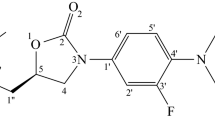Abstract
Tetracyclines inhibit ribosomal functions. From the observed interference of the antibiotics with initiation and elongation steps in cell-free systems of peptide synthesis, it was concluded that tetracyclines block the A-site of the 30S ribosomal subunit (see Pestka, 1971, for summarizing references).
Access this chapter
Tax calculation will be finalised at checkout
Purchases are for personal use only
Preview
Unable to display preview. Download preview PDF.
Similar content being viewed by others
References
FEY, G., M. REISS, and H. KERSTEN: Interaction of tetracyclines with ribosomal subunits from Escherichia coli. A fluorometric investigation. Biochemistry 12, 1160–1164 (1973).
HASELTINE, W.A., and R BLOCK: Synthesis of guanosine tetra-and pentaphosphate requires the presence of a codon-specific, uncharged transfer ribonucleic acid in the acceptor site of ribosomes. Proc. Nat. Acad. Sci. USA 70, 1564–1568 (1973)
KERSTEN, H.: Changes in the properties of ribosomes and transfer RNA induced by inhibitors of protein synthesis. In: Progress in Molecular and Subcellular Biology, Vol. 2, (Hahn, F.E., ed.) pp. 58–68, Berlin-Heidelberg-New York: Springer 1971.
LUND, E., and N.O. KJELDGAARD: Metabolism of guanosine tetraphosphate in Escherichia coli. Eur. J. Biochem. 28, 316–326 (1972).
MANN, M.B., and P.C. HUANG: Behavior of chloramphenicol-induced phenylalanine transfer ribonucleic acid during recovery from chloramphenicol treatment in Escherichia coli. Biochemistry 12, 5289–5294 (1973).
PESTKA, S.: Inhibitions of ribosome functions. Ann. Rev.Microbiol. 25, 487–562 (1971).
SCHELLBERGER, H., and H. KERSTEN: Arginine dependent occurrence of a new isoaccepting tRNA Phe in E. coli. Abstr. FEBS Meeting, Budapest 1974.
WATERS, L.C., L. SHUGART, W.-K. YANG, and A.N. BEST: Some physical and biological properties of 4-thiouridine-and dihydro-uridinedeficient tRNA from chloramphenicol-treated Escherichia coli. Arch. Biochem. Biophys. 156, 780–793 (1973).
WHITE, J.P., and C.R. CANTOR: Role of magnesium in the binding of tetracycline to Escherichia coli ribosomes. J. Mol. Biol. 58, 397–400 (1971).
Editor information
Editors and Affiliations
Rights and permissions
Copyright information
© 1975 Springer-Verlag/Wien
About this paper
Cite this paper
Kersten, H. (1975). Binding of Tetracyclines and Other Antibiotics to Ribosomes. In: Drews, J., Hahn, E. (eds) Drug Receptor Interactions in Antimicrobial Chemotherapy. Topics in Infectious Diseases, vol 1. Springer, Vienna. https://doi.org/10.1007/978-3-7091-8405-9_11
Download citation
DOI: https://doi.org/10.1007/978-3-7091-8405-9_11
Publisher Name: Springer, Vienna
Print ISBN: 978-3-7091-8407-3
Online ISBN: 978-3-7091-8405-9
eBook Packages: Springer Book Archive




